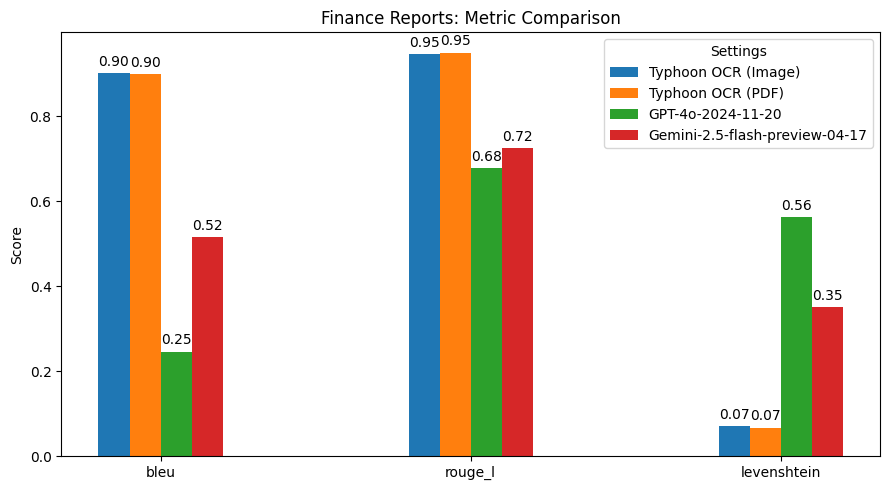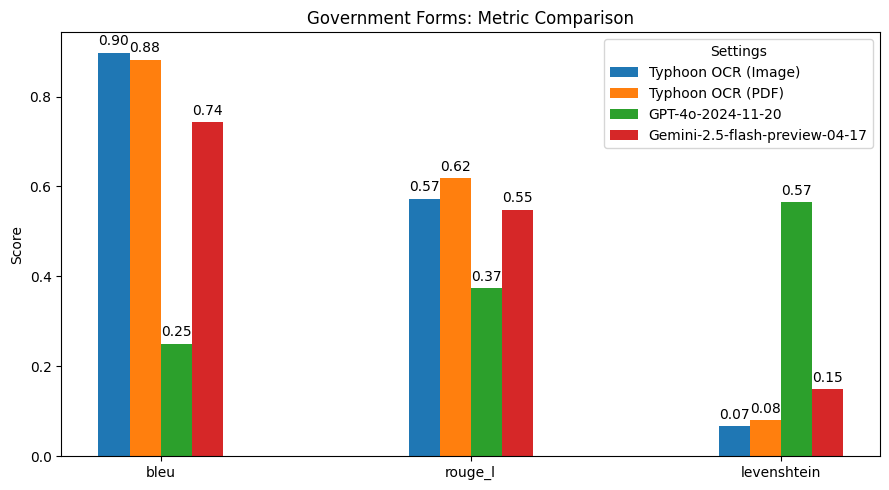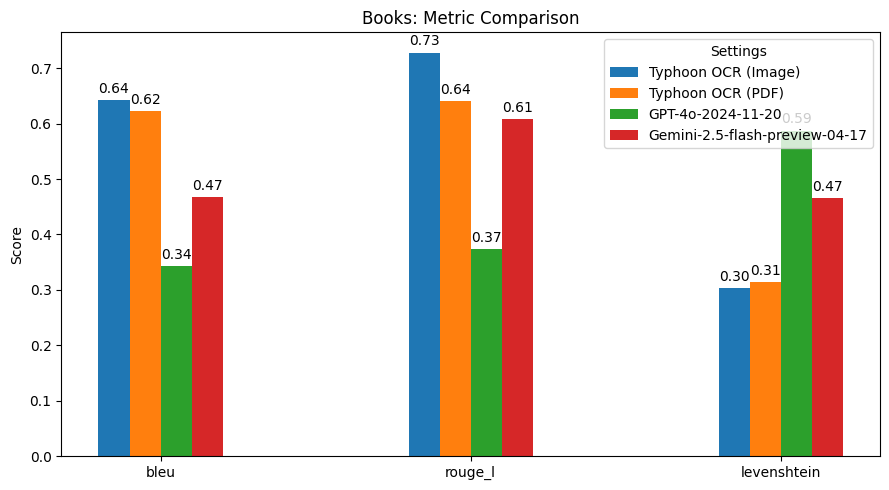 Transformers
TransformersModel Overview
Model Features
Model Capabilities
Use Cases
🚀 Typhoon-OCR-7B
Typhoon-OCR-7B is a bilingual document parsing model. Inspired by models like olmOCR and based on Qwen2.5-VL-Instruction, it is specifically designed for real - world documents in Thai and English.
- Demo: Try our demo
- Code / Examples: Available on Github
- Release Blog: OpenTyphoon Blog
⚠️ Important Note
This model is intended to be used with a specific prompt only; it will not work with any other prompts.
🚀 Quick Start
You can quickly start using Typhoon-OCR-7B through the following ways:
- Try the online demo.
- Check the code and examples on Github.
- Read the release blog on OpenTyphoon Blog.
✨ Features
Real - World Document Support
1. Structured Documents
Supported document types include financial reports, academic papers, books, and government forms.
Output format:
- General text is in Markdown format.
- Tables (including merged cells and complex layouts) are in HTML format.
- Figures, charts, and diagrams are represented using figure tags for structured visual understanding.
Each figure undergoes multi - layered interpretation:
- Observation: Detects elements such as landscapes, buildings, people, logos, and embedded text.
- Context Analysis: Infers context like location, event, or document section.
- Text Recognition: Extracts and interprets embedded text (e.g., chart labels, captions) in Thai or English.
- Artistic & Structural Analysis: Captures layout style, diagram type, or design choices contributing to document tone.
- Final Summary: Combines all insights into a structured figure description for tasks like summarization and retrieval.
2. Layout - Heavy & Informal Documents
Supported document types include receipts, menus, tickets, and infographics.
Output format: Markdown with embedded tables and layout - aware structures.
Performance



Summary of Findings
Typhoon OCR outperforms both GPT - 4o and Gemini 2.5 Flash in Thai document understanding, especially on documents with complex layouts and mixed - language content. However, in the Thai books benchmark, performance slightly declined due to the high frequency and diversity of embedded figures. These images vary significantly in type and structure, which poses challenges for the current figure tag parsing. This highlights a potential area for future improvement, specifically in enhancing the model's image understanding capabilities. For this version, the primary focus has been on achieving high - quality OCR for both English and Thai text. Future releases may extend support to more advanced image analysis and figure interpretation.
📦 Installation
You can install the typhoon-ocr package using the following command:
pip install typhoon-ocr
💻 Usage Examples
Basic Usage
from typhoon_ocr import ocr_document
# please set env TYPHOON_OCR_API_KEY or OPENAI_API_KEY to use this function
markdown = ocr_document("test.png")
print(markdown)
Advanced Usage
API
from typing import Callable
from openai import OpenAI
from PIL import Image
from typhoon_ocr.ocr_utils import render_pdf_to_base64png, get_anchor_text
PROMPTS_SYS = {
"default": lambda base_text: (f"Below is an image of a document page along with its dimensions. "
f"Simply return the markdown representation of this document, presenting tables in markdown format as they naturally appear.\n"
f"If the document contains images, use a placeholder like dummy.png for each image.\n"
f"Your final output must be in JSON format with a single key `natural_text` containing the response.\n"
f"RAW_TEXT_START\n{base_text}\nRAW_TEXT_END"),
"structure": lambda base_text: (
f"Below is an image of a document page, along with its dimensions and possibly some raw textual content previously extracted from it. "
f"Note that the text extraction may be incomplete or partially missing. Carefully consider both the layout and any available text to reconstruct the document accurately.\n"
f"Your task is to return the markdown representation of this document, presenting tables in HTML format as they naturally appear.\n"
f"If the document contains images or figures, analyze them and include the tag <figure>IMAGE_ANALYSIS</figure> in the appropriate location.\n"
f"Your final output must be in JSON format with a single key `natural_text` containing the response.\n"
f"RAW_TEXT_START\n{base_text}\nRAW_TEXT_END"
),
}
def get_prompt(prompt_name: str) -> Callable[[str], str]:
"""
Fetches the system prompt based on the provided PROMPT_NAME.
:param prompt_name: The identifier for the desired prompt.
:return: The system prompt as a string.
"""
return PROMPTS_SYS.get(prompt_name, lambda x: "Invalid PROMPT_NAME provided.")
# Render the first page to base64 PNG and then load it into a PIL image.
image_base64 = render_pdf_to_base64png(filename, page_num, target_longest_image_dim=1800)
image_pil = Image.open(BytesIO(base64.b64decode(image_base64)))
# Extract anchor text from the PDF (first page)
anchor_text = get_anchor_text(filename, page_num, pdf_engine="pdfreport", target_length=8000)
# Retrieve and fill in the prompt template with the anchor_text
prompt_template_fn = get_prompt(task_type)
PROMPT = prompt_template_fn(anchor_text)
messages = [{
"role": "user",
"content": [
{"type": "text", "text": PROMPT},
{"type": "image_url", "image_url": {"url": f"data:image/png;base64,{image_base64}"}},
],
}]
# send messages to openai compatible api
openai = OpenAI(base_url="https://api.opentyphoon.ai/v1", api_key="TYPHOON_API_KEY")
response = openai.chat.completions.create(
model="typhoon-ocr-preview",
messages=messages,
max_tokens=16384,
temperature=0.1,
top_p=0.6,
extra_body={
"repetition_penalty": 1.2,
},
)
text_output = response.choices[0].message.content
print(text_output)
Local Model (GPU Required)
import torch
from PIL import Image
import base64
from io import BytesIO
from transformers import Qwen2_5_VLForConditionalGeneration, AutoProcessor
# Initialize the model
model = Qwen2_5_VLForConditionalGeneration.from_pretrained("scb10x/typhoon-ocr-7b", torch_dtype=torch.bfloat16 ).eval()
processor = AutoProcessor.from_pretrained("scb10x/typhoon-ocr-7b")
device = torch.device("cuda" if torch.cuda.is_available() else "cpu")
model.to(device)
# Apply the chat template and processor
text = processor.apply_chat_template(messages, tokenize=False, add_generation_prompt=True)
main_image = Image.open(BytesIO(base64.b64decode(image_base64)))
inputs = processor(
text=[text],
images=[main_image],
padding=True,
return_tensors="pt",
)
inputs = {key: value.to(device) for (key, value) in inputs.items()}
# Generate the output
output = model.generate(
**inputs,
temperature=0.1,
max_new_tokens=12000,
num_return_sequences=1,
repetition_penalty=1.2,
do_sample=True,
)
# Decode the output
prompt_length = inputs["input_ids"].shape[1]
new_tokens = output[:, prompt_length:]
text_output = processor.tokenizer.batch_decode(
new_tokens, skip_special_tokens=True
)
print(text_output[0])
📚 Documentation
Prompting
This model only works with the specific prompts defined below, where {base_text} refers to information extracted from the PDF metadata using the get_anchor_text function from the typhoon-ocr package. It will not function correctly with any other prompts.
PROMPTS_SYS = {
"default": lambda base_text: (f"Below is an image of a document page along with its dimensions. "
f"Simply return the markdown representation of this document, presenting tables in markdown format as they naturally appear.\n"
f"If the document contains images, use a placeholder like dummy.png for each image.\n"
f"Your final output must be in JSON format with a single key `natural_text` containing the response.\n"
f"RAW_TEXT_START\n{base_text}\nRAW_TEXT_END"),
"structure": lambda base_text: (
f"Below is an image of a document page, along with its dimensions and possibly some raw textual content previously extracted from it. "
f"Note that the text extraction may be incomplete or partially missing. Carefully consider both the layout and any available text to reconstruct the document accurately.\n"
f"Your task is to return the markdown representation of this document, presenting tables in HTML format as they naturally appear.\n"
f"If the document contains images or figures, analyze them and include the tag <figure>IMAGE_ANALYSIS</figure> in the appropriate location.\n"
f"Your final output must be in JSON format with a single key `natural_text` containing the response.\n"
f"RAW_TEXT_START\n{base_text}\nRAW_TEXT_END"
),
}
Generation Parameters
We suggest using the following generation parameters. Since this is an OCR model, a high temperature is not recommended. Make sure the temperature is set to 0 or 0.1, not higher.
temperature=0.1,
top_p=0.6,
repetition_penalty: 1.2
Intended Uses & Limitations
This is a task - specific model intended to be used only with the provided prompts. It does not include any guardrails or VQA capability. Due to the nature of large language models (LLMs), a certain level of hallucination may occur. We recommend that developers carefully assess these risks in the context of their specific use case.
📄 License
No license information provided in the original document.
Follow us
https://twitter.com/opentyphoon
Support
Citation
If you find Typhoon2 useful for your work, please cite it using:
@misc{typhoon2,
title={Typhoon 2: A Family of Open Text and Multimodal Thai Large Language Models},
author={Kunat Pipatanakul and Potsawee Manakul and Natapong Nitarach and Warit Sirichotedumrong and Surapon Nonesung and Teetouch Jaknamon and Parinthapat Pengpun and Pittawat Taveekitworachai and Adisai Na-Thalang and Sittipong Sripaisarnmongkol and Krisanapong Jirayoot and Kasima Tharnpipitchai},
year={2024},
eprint={2412.13702},
archivePrefix={arXiv},
primaryClass={cs.CL},
url={https://arxiv.org/abs/2412.13702},
}
 Transformers
Transformers Transformers
Transformers Transformers
Transformers Transformers English
Transformers English Transformers
Transformers Transformers
Transformers Transformers English
Transformers English